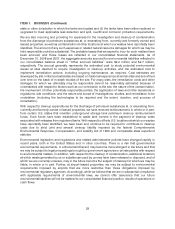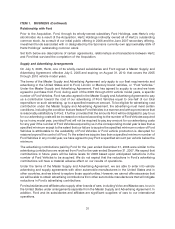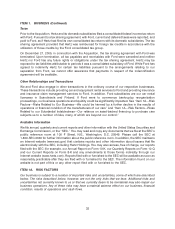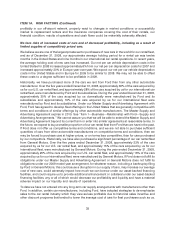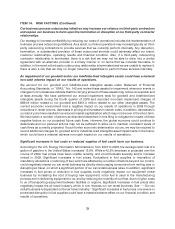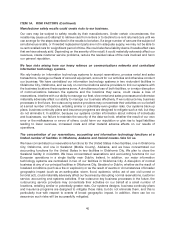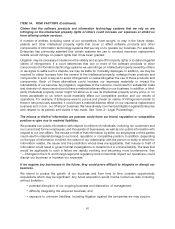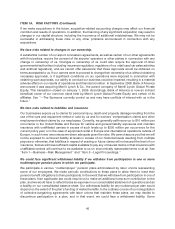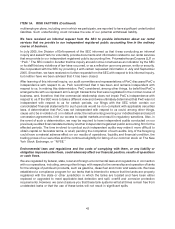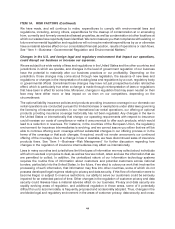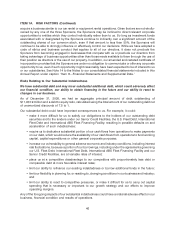Hertz 2008 Annual Report Download - page 57
Download and view the complete annual report
Please find page 57 of the 2008 Hertz annual report below. You can navigate through the pages in the report by either clicking on the pages listed below, or by using the keyword search tool below to find specific information within the annual report.ITEM 1A. RISK FACTORS (Continued)
holding period requirements for returned cars) from one program year to another to make it
disadvantageous to acquire certain cars. Any failure of our car manufacturers to fulfill their current
repurchase or guaranteed obligations, or modification or elimination of such programs in the future,
would increase our exposure to the risks described in the preceding paragraphs. In addition, because
we obtain a substantial portion of our financing in reliance on repurchase and guaranteed depreciation
programs, the failure of our car manufacturers to fulfill their current repurchase obligations, or
modification or elimination of those programs in the future, or significant adverse changes in the financial
condition of our car manufacturers, including a bankruptcy filing by a significant supplier, could
adversely impact our outstanding asset-backed financing facilities and could in the future make vehicle-
related debt financing more difficult to obtain on reasonable terms. See ‘‘—Risks Related to our
Substantial Indebtedness—Our reliance on asset-backed financing to purchase cars subjects us to a
number of risks, many of which are beyond our control.’’
We could be harmed by a further decline in the results of operations or financial condition of the
manufacturers of our cars.
As of December 31, 2008, approximately 24% of our fleet consisted of cars purchased from Ford, of
which approximately 32% were program cars and approximately 28% of our fleet consisted of cars
purchased from General Motors, of which approximately 32% were program cars. In the past several
years, Ford and General Motors have experienced deterioration in their operating results and significant
declines in their credit ratings.
A continued decline in the results of operations or financial condition of a manufacturer of cars that we
own could reduce such cars’ residual values, particularly to the extent that the manufacturer
unexpectedly announced the eventual elimination of a model or nameplate or immediately ceased
manufacturing them altogether. Such a reduction in residual values could cause us to sustain a loss on
the ultimate sale of non-program cars, on which we bear the risk of such declines in residual value, or
require us to depreciate those cars on a more rapid basis while we own them. A decline in the economic
and business prospects of car manufacturers, including any economic distress impacting the suppliers
of car components to manufacturers, could also cause manufacturers to raise the prices we pay for cars
or reduce their supply to us.
In addition, if a decline in results or conditions were so severe as to cause a manufacturer to default on
an obligation to repurchase or guarantee the depreciation of program cars we own, or to cause a
manufacturer to commence bankruptcy reorganization proceedings, and reject its repurchase or
guaranteed depreciation obligations, or if any manufacturer of our cars does not fulfill its obligations
under our current arrangement with them, for whatever reason, we would have to dispose of those
program cars without the benefits of the associated programs. This could significantly increase our
expenses. In addition, disposing of program cars following a manufacturer default or rejection of the
program in bankruptcy could result in losses on cars that have become ineligible for return or sale under
the applicable program. Such losses could be material if a large number of program cars were affected.
For example, we estimate that if Ford Motor Company, but not its subsidiaries, had filed for bankruptcy
reorganization and rejected all its commitments to repurchase program cars from us, based upon the
highest number of Ford program cars we had in the year ended December 31, 2008, we would have
sustained material losses in the U.S., which would have been as high as $205.0 million, upon disposition
of those cars. A reduction in the number of program cars that we buy would reduce the magnitude of this
exposure, but it would simultaneously increase our exposure to residual value risk. See ‘‘—We face risks
related to decreased acquisition or disposition of cars through repurchase and guaranteed depreciation
programs.’’
37




